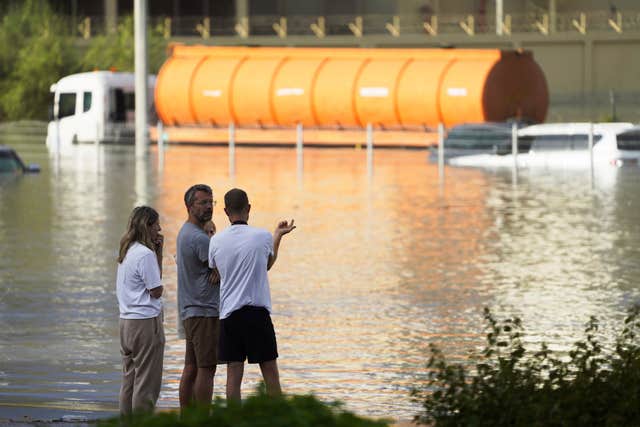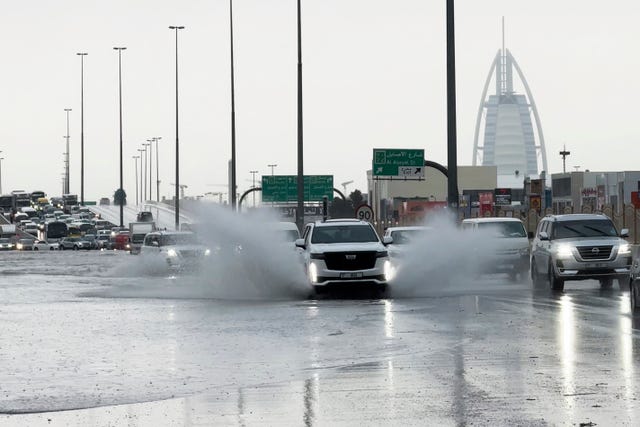Storm dumps heaviest rain ever recorded in UAE, flooding roads and Dubai airport
By the end of Tuesday, more than 5.6in (142mm) of rain had soaked Dubai over 24 hours.

The United Arab Emirates is attempting to dry out after the heaviest rain ever recorded in the desert nation.
The deluge flooded Dubai International Airport, disrupting flights through the world’s busiest hub for international travel.
The state-run WAM news agency called Tuesday’s rain “a historic weather event” that surpassed “anything documented since the start of data collection in 1949”. That was before the discovery of crude oil in the energy-rich nation which was then part of a British protectorate known as the Trucial States.
Rain also fell in Bahrain, Qatar and Saudi Arabia.

Several reports quoted meteorologists at the National Centre for Meteorology as saying they flew six or seven cloud-seeding flights before the rain. The centre did not immediately respond to questions on Wednesday, though flight-tracking data analysed by the Associated Press showed one aircraft affiliated with the UAE’s cloud-seeding efforts flew around the country on Sunday.
The UAE, which relies heavily on energy-hungry desalination plants to provide water, carries out cloud seeding in part to increase its dwindling, limited groundwater.
The rain began late on Monday, soaking the sands and roads of Dubai with some 0.8in (20mm) of rain, according to meteorological data collected at Dubai International Airport.

By the end of Tuesday, more than 5.6in (142mm) of rain had soaked Dubai over 24 hours. An average year sees 3.7in (94.7mm) of rain at Dubai International Airport, a hub for the long-haul carrier Emirates.
At the airport, standing water lapped on taxiways as aircraft landed. Arrivals were halted on Tuesday night, and passengers struggled to reach terminals through the floodwater covering surrounding roads.
One couple, who spoke to the AP on condition of anonymity to speak freely in a country with strict laws that criminalise critical speech, called the situation at the airport “absolute carnage”.
“You cannot get a taxi. There’s people sleeping in the Metro station. There’s people sleeping in the airport,” the man said on Wednesday.
They ended up getting a taxi to close to their home some 18 miles (30km) away, but floodwater on the road stopped them. A bystander helped them over a highway barrier with their carry-on luggage.
Dubai International Airport acknowledged on Wednesday morning that the flooding had left “limited transportation options” and affected flights as aircraft crews were unable to reach the airfield.
“Recovery will take some time,” the airport said on the social media platform X, formerly Twitter. “We thank you for your patience and understanding while we work through these challenges.”
Emirates said the airline had halted check-in for passengers departing from Dubai itself from 8am until midnight on Wednesday as it tried to clear the airport of transit passengers – many of whom had been sleeping where they could in its cavernous terminals.
“We sincerely apologise for the inconvenience caused,” the airline said on X. “Emirates is working hard to restore our scheduled operations.”
Passengers on FlyDubai, Emirates’ low-cost sister airline, also faced disruptions.
Paul Griffiths, the airport’s chief executive, acknowledged continued issues with flooding on Wednesday morning, saying every place an aircraft could be safely parked was taken.
Some aircraft had been diverted to Al Maktoum International Airport at Dubai World Central, the city-state’s second airfield.
“It remains an incredibly challenging time. In living memory, I don’t think anyone has ever seen conditions like it,” Mr Griffiths told the state-owned talk radio station Dubai Eye.
“We are in uncharted territory, but I can assure everyone we are working as hard as we possibly can to make sure our customers and staff are looked after.”
Schools across the UAE, a federation of seven sheikhdoms, largely shut ahead of the storm and government employees were largely working remotely if able.
Many workers also stayed at home, though some ventured out, with some finding their vehicles stranded in deeper-than-expected water covering some roads.
Authorities sent tanker trucks out into the streets and highways to pump away the water. Water poured into some homes, forcing people to bail out their houses.
The country’s hereditary rulers offered no overall damage or injury information for the nation, as some people slept in their flooded vehicles on Tuesday night.
In Ras al-Khaimah, the country’s northernmost emirate, police said one 70-year-old man died when his vehicle was swept away by floodwater.

Authorities cancelled school and the government instituted remote working again for Wednesday.
Rain is unusual in the UAE, an arid, Arabian Peninsula nation, but occurs periodically during the cooler winter months. Many roads and other areas lack drainage given the lack of regular rainfall, causing flooding.
Meanwhile, in neighbouring Oman, a sultanate on the eastern edge of the Arabian Peninsula, at least 18 people were killed in heavy rain in recent days, according to a statement on Tuesday from the country’s National Committee for Emergency Management.
That includes some 10 schoolchildren swept away in a vehicle with an adult, which saw condolences come into the country from rulers across the region.





